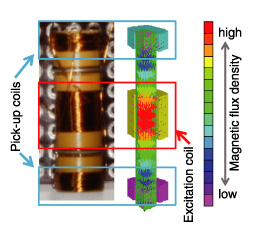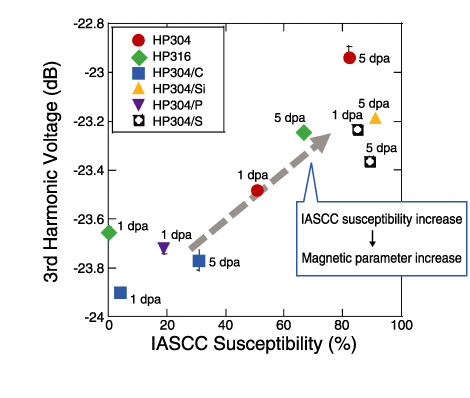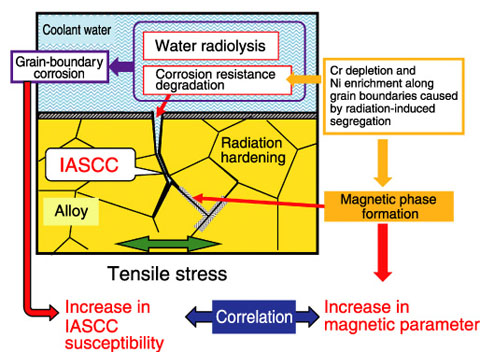
Fig.7-18 “I”-shaped sensor probe and calculation results of its magnetic characteristics

Fig.7-19 Correlation between magnetic data and IASCC susceptibility

Fig.7-20 Mechanism of correlation between magnetic data and IASCC susceptibility
Many of the problems experienced in light water reactors (LWRs) are caused by damage to structural materials. Stress corrosion cracking (SCC) and irradiation-assisted SCC (IASCC) have been especially serious problems, but their prediction in the design process has not been possible.
Conventional nondestructive evaluation methods for nuclear reactor components are capable of crack detection. In the meantime, if we are able to develop a diagnostic technique that can detect material degradation before crack initiation, it will be useful for reinforcing the safety measures in nuclear reactor systems.
The eddy current method and alternating current (AC) magnetization method were chosen for the development of predictive IASCC diagnosis, because these methods are more suitable for application in actual reactors than any others. In this study, an “I”-shaped sensor probe was developed (Fig.7-18). Calculations and mock-up tests were carried out for optimization of the sensor design to obtain higher measurement accuracy. Moreover, the tolerance to the environmental conditions in the reactor during the maintenance period was confirmed by testing. A remote-control system equipped with the sensor probe was developed, and its performance was evaluated.
The specimens used in the study were as follows: high-purity austenitic stainless alloys with six different chemical compositions, neutron-irradiated up to 1 dpa and 5 dpa; and type-316L stainless steel, neutron-irradiated with up to three doses around 1 dpa (because 1 dpa is considered as the threshold for IASCC in previous studies). The magnetic data obtained by both the eddy current and AC magnetization methods showed correlations with the IASCC susceptibilities of the specimens (Fig.7-19).
For investigation of the mechanism of this correlation, the relations between the microstructures and magnetic properties of the neutron-irradiated and mock-up specimens were evaluated through experiments and calculations. It was revealed that magnetic-phase formation along the grain boundaries, which came from the change in chemical composition caused by radiation-induced segregation, was the mechanism of the correlation between the IASCC susceptibilities and the magnetic data (Fig.7-20).
The outcome of this research showed the feasibility of predictive diagnosis that can detect material degradation before IASCC initiation. This will contribute to the safety and reliability of nuclear reactors.
The present study includes the results of the project “Development of a diagnostic method of in-core structure material degradation for super-critical water-cooled fast breeder reactors” entrusted by the Ministry of Education, Culture, Sports, Science and Technology of Japan (MEXT). The scientific paper of this study received the first “Best Paper Award” from the Japan Society of Maintenology in 2011.